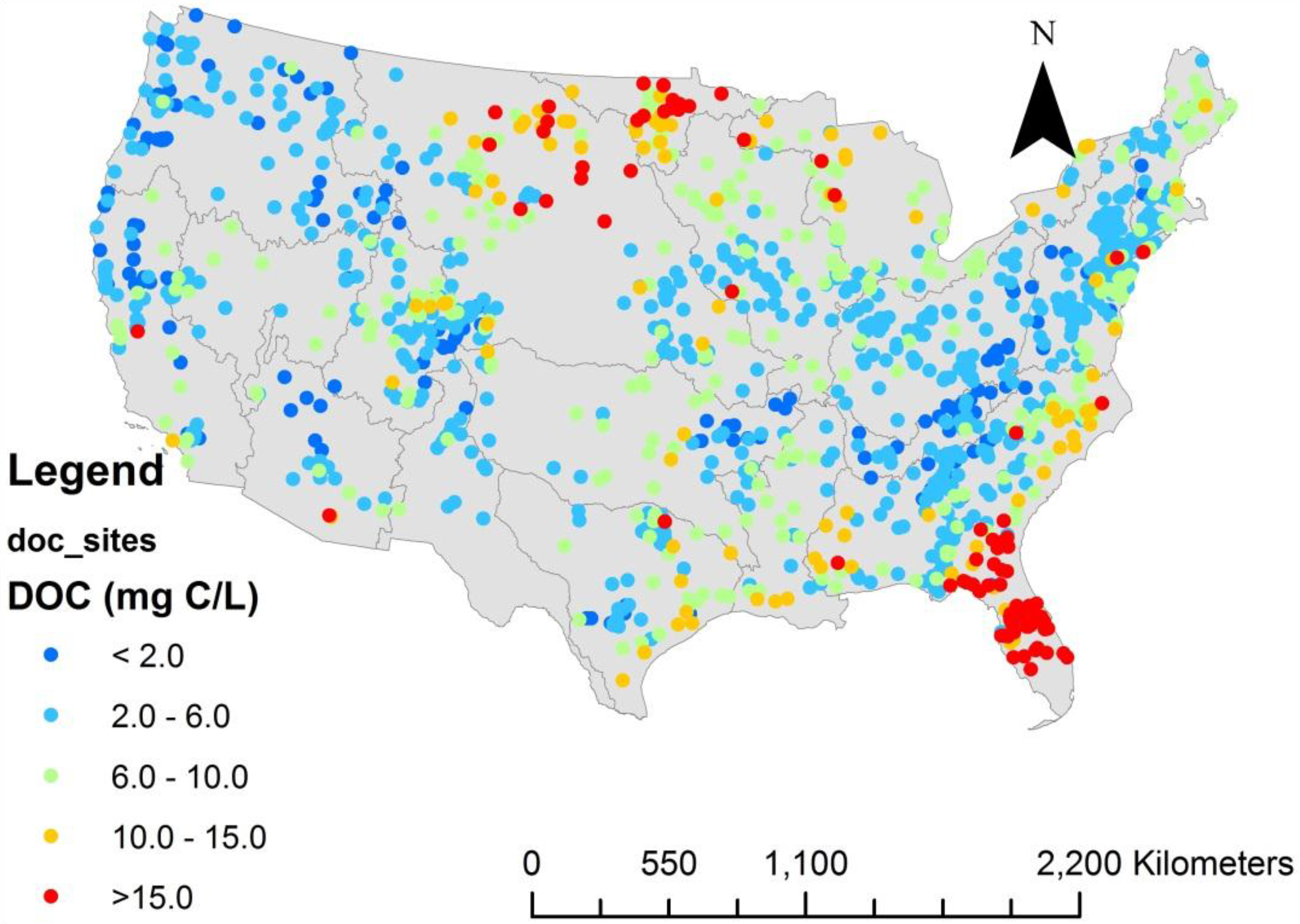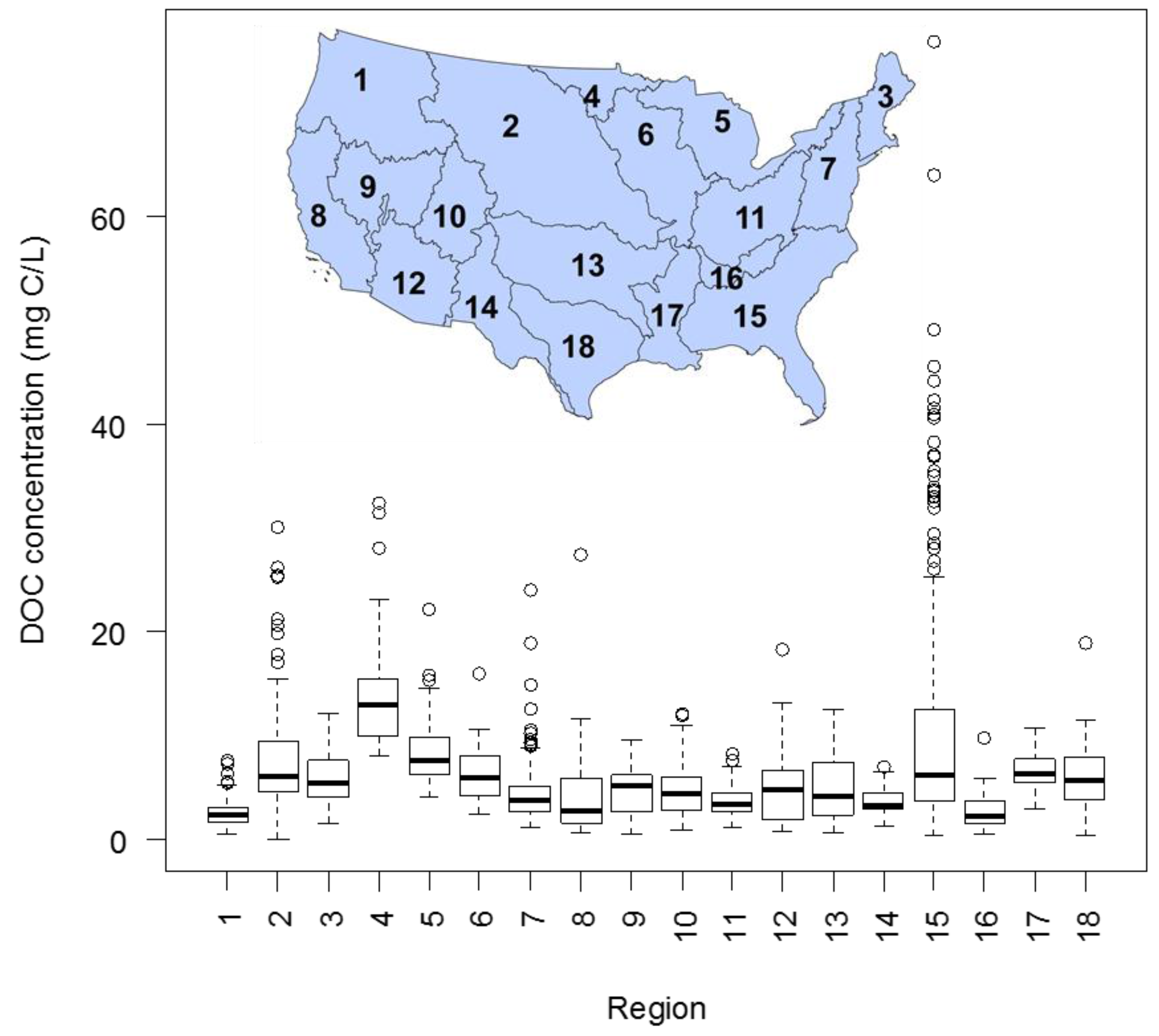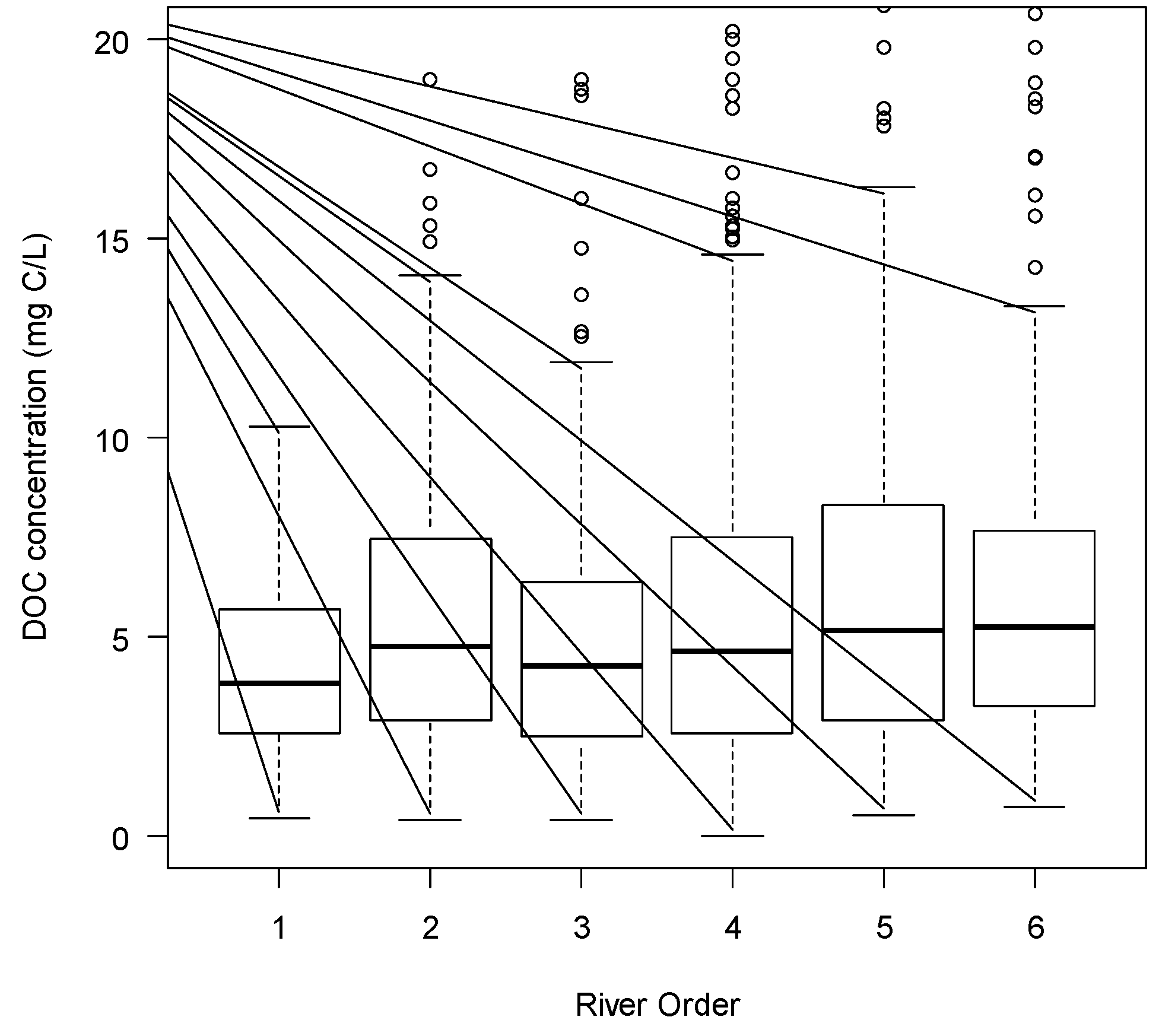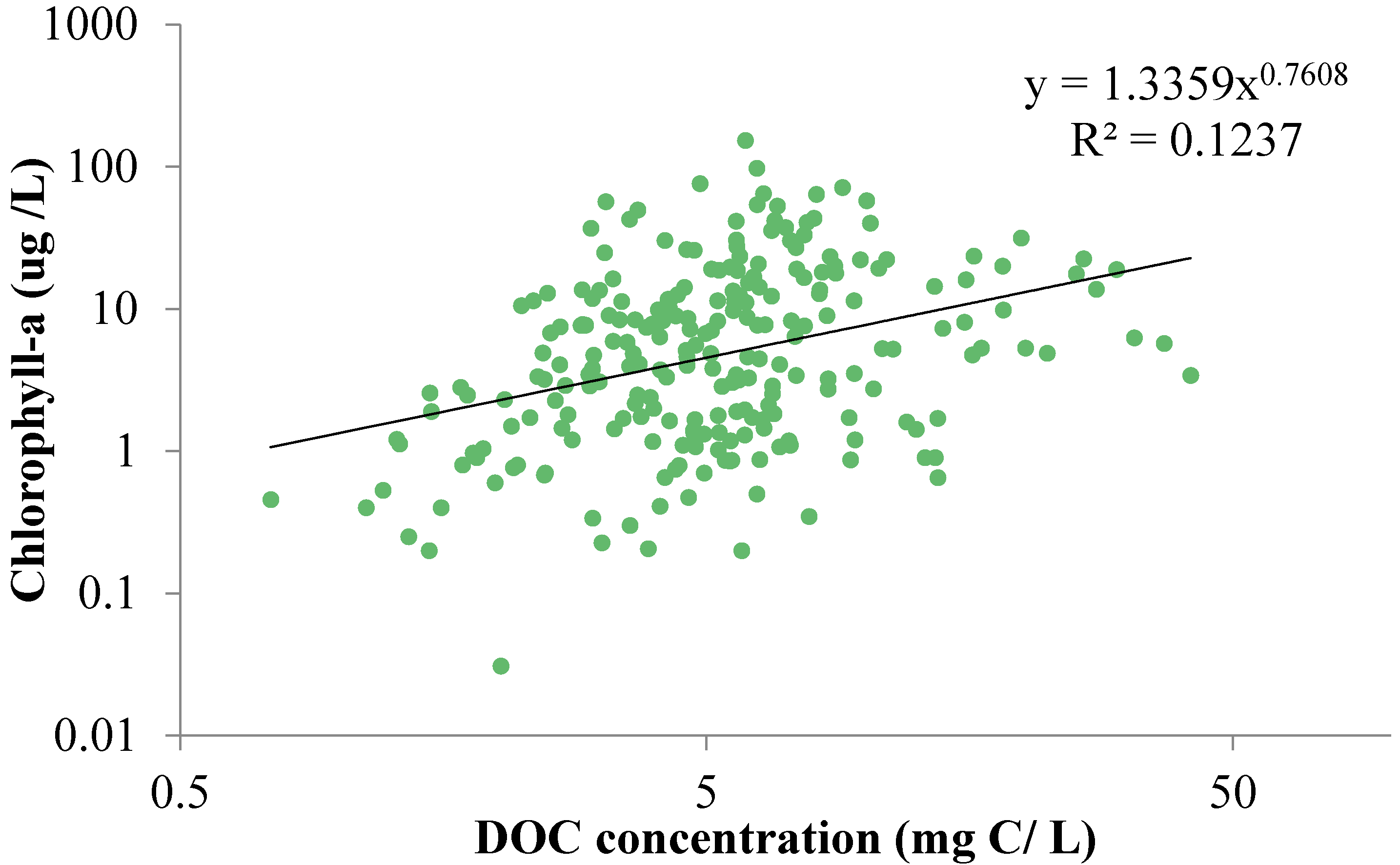An Analysis of Terrestrial and Aquatic Environmental Controls of Riverine Dissolved Organic Carbon in the Conterminous United States
Abstract
:1. Introduction
2. Methods
Data Compilation and Statistical Analysis
3. Results
3.1. Spatial Variability of DOC Concentrations in the U.S.
3.2. Bivariate Analyses of Impacts of Environmental Factors on DOC Concentrations
3.3. Multivariate Analyses of Environmental Impacts on DOC Concentrations
3.4. DOC Variability and Environmental Controls by River Orders
4. Discussion
4.1. Spatial Patterns of DOC Concentrations
4.2. Environmental Controls on DOC Concentrations
4.3. Interplays among Multiple Processes in Determining DOC Concentrations
4.4. Uncertainties and Future Work
5. Conclusions
Supplementary Materials
Acknowledgments
Author Contributions
Conflicts of Interest
References
- Cole, J.J.; Prairie, Y.T.; Caraco, N.F.; McDowell, W.H.; Tranvik, L.J.; Striegl, R.G.; Duarte, C.M.; Kortelainen, P.; Downing, J.A.; Middelburg, J.J.; et al. Plumbing the Global Carbon Cycle: Integrating Inland Waters into the Terrestrial Carbon Budget. Ecosystems 2007, 10, 172–185. [Google Scholar] [CrossRef]
- Butman, D.; Raymond, P. Significant efflux of carbon dioxide from streams and rivers in the US_supplementary. Nat. Geosci. 2011, 4, 839–842. [Google Scholar] [CrossRef]
- Raymond, P.A.; Oh, N.-H.; Turner, R.E.; Broussard, W. Anthropogenically enhanced fluxes of water and carbon from the Mississippi River. Nature 2008, 451, 449–452. [Google Scholar] [CrossRef] [PubMed]
- Battin, T.J.; Luyssaert, S.; Kaplan, L.A.; Aufdenkampe, A.K.; Richter, A.; Tranvik, L.J. The boundless carbon cycle. Nat. Geosci. 2009, 2, 598–600. [Google Scholar] [CrossRef]
- Pan, Y.; Birdsey, R.A.; Fang, J.; Houghton, R.; Kauppi, P.E.; Kurz, W.A.; Phillips, O.L.; Shvidenko, A.; Lewis, S.L.; Canadell, J.G.; et al. A large and persistent carbon sink in the world’s forests. Science 2011, 333, 988–993. [Google Scholar] [CrossRef] [PubMed]
- Ciais, P.; Sabine, C.; Bala, G.; Bopp, L.; Brovkin, V.; Canadell, J.; Chhabra, A.; DeFries, R.; Galloway, J.; Heimann, M.; et al. Carbon and Other Biogeochemical Cycles. In Climate Change 2013; Cambridge University Press: Cambridge, UK, 2013; pp. 465–570. [Google Scholar]
- Regnier, P.; Friedlingstein, P.; Ciais, P.; Mackenzie, F.T.; Gruber, N.; Janssens, I.A.; Laruelle, G.G.; Lauerwald, R.; Luyssaert, S.; Andersson, A.J.; et al. Anthropogenic perturbation of the carbon fluxes from land to ocean. Nat. Geosci. 2013, 6, 597–607. [Google Scholar] [CrossRef]
- Mayorga, E.; Seitzinger, S.P.; Harrison, J.A.; Dumont, E.; Beusen, A.H.W.; Bouwman, A.F.; Fekete, B.M.; Kroeze, C.; Van Drecht, G. Global Nutrient Export from WaterSheds 2 (NEWS 2): Model development and implementation. Environ. Model. Softw. 2010, 25, 837–853. [Google Scholar] [CrossRef]
- Stets, E.G.; Striegl, R.G. Carbon export by rivers draining the conterminous United States. Inland Waters 2012, 2, 177–184. [Google Scholar] [CrossRef]
- Marschner, B.; Kalbitz, K. Controls of bioavailability and biodegradability of dissolved organic matter in soils. Geoderma 2003, 113, 211–235. [Google Scholar] [CrossRef]
- Tranvik, L.J. Allochthonous dissolved organic matter as an energy source for pelagic bacteria and the concept of the microbial loop. Hydrobiologia 1992, 229, 107–114. [Google Scholar] [CrossRef]
- Freeman, C.; Lock, M.A. The biofilm polysaccharide matrix: A buffer against changing organic substrate supply? Limnol Oceanogr. 1995, 40, 273–278. [Google Scholar] [CrossRef]
- Dillon, P.J.; Molot, L.A. Dissolved organic and inorganic carbon mass balances in central Ontario lakes. Biogeochemistry 1997, 36, 29–42. [Google Scholar] [CrossRef]
- Scharnweber, K.; Vanni, M.J.; Hilt, S.; Syväranta, J.; Mehner, T. Boomerang ecosystem fluxes: Organic carbon inputs from land to lakes are returned to terrestrial food webs via aquatic insects. Oikos 2014, 123, 1439–1448. [Google Scholar] [CrossRef]
- Cai, W.-J. Estuarine and Coastal Ocean Carbon Paradox: CO2 Sinks or Sites of Terrestrial Carbon Incineration? Ann. Rev. Mar. Sci. 2011, 3, 123–145. [Google Scholar] [CrossRef] [PubMed]
- Bauer, J.E.; Cai, W.-J.; Raymond, P.A.; Bianchi, T.S.; Hopkinson, C.S.; Regnier, P.A.G. The changing carbon cycle of the coastal ocean. Nature 2013, 504, 61–70. [Google Scholar] [CrossRef] [PubMed]
- Jones, T.G.; Evans, C.D.; Jones, D.L.; Hill, P.W.; Freeman, C. Transformations in DOC along a source to sea continuum: Impacts of photo-degradation, biological processes and mixing. Aquat Sci. 2016, 78, 433–446. [Google Scholar] [CrossRef]
- Kalbitz, K.; Solinger, S.; Park, J.-H.; Michalzik, B.; Matzner, E. Controls on the dynamics of dissolved organic matter in soils: A review. Soil Sci. 2000, 165, 277–304. [Google Scholar] [CrossRef]
- Cox, P.M.; Betts, R.A.; Jones, C.D.; Spall, S.A.; Totterdell, I.J. Acceleration of global warming due to carbon-cycle feedbacks in a coupled climate model. Nature 2000, 408, 184–187. [Google Scholar] [CrossRef] [PubMed]
- Gielen, B.; Neirynck, J.; Luyssaert, S.; Janssens, I.A. The importance of dissolved organic carbon fluxes for the carbon balance of a temperate Scots pine forest. Agric. For. Meteorol. 2011, 151, 270–278. [Google Scholar] [CrossRef]
- Freeman, C.; Evans, C.D.; Monteith, D.T.; Reynolds, B.; Fenner, N. Export of organic carbon from peat soils. Nature 2001, 412, 785. [Google Scholar] [CrossRef] [PubMed]
- Pastor, J.; Solin, J.; Bridgham, S.D.; Updegraff, K.; Harth, C.; Weishampel, P. Global warming and the export of dissolved organic carbon from boreal peatlands. Oikos 2003, 100, 380–386. [Google Scholar] [CrossRef]
- Wallin, M.; Buffam, I.; Öquist, M.; Laudon, H.; Bishop, K. Temporal and spatial variability of dissolved inorganic carbon in a boreal stream network: Concentrations and downstream fluxes. J. Geophys. Res. 2010, 115, 1–12. [Google Scholar] [CrossRef]
- Delpla, I.; Jones, T.G.; Monteith, D.T.; Hughesb, D.D.; Baurèsa, E.; Junga, A.; Thomasa, O.; Freeman, C. Heavy Rainfall Impacts on Trihalomethane Formation in Contrasting Northwestern European Potable Waters. J. Environ. Qual. 2015, 44, 1241–1251. [Google Scholar] [CrossRef] [PubMed]
- Raymond, P.; Oh, N.-H. An empirical study of climatic controls on riverine C export from three major U.S. watersheds. Glob. Biogeochem. Cycles 2007, 21. [Google Scholar] [CrossRef]
- Raymond, P.A.; Saiers, J.E. Event controlled DOC export from forested watersheds. Biogeochemistry 2010, 100, 197–209. [Google Scholar] [CrossRef]
- Sawicka, K.; Monteith, D.T.; Vanguelova, E.I.; Wade, A.J.; Clark, J.M. Fine-scale temporal characterization of trends in soil water dissolved organic carbon and potential drivers. Ecol. Indic. 2016, 68, 36–51. [Google Scholar] [CrossRef]
- Meyer-Jacob, C.; Tolu, J.; Bigler, C.; Yang, H.; Bindler, R. Early land use and centennial scale changes in lake-water organic carbon prior to contemporary monitoring. Proc. Natl. Acad. Sci. USA 2015, 112, 6579–6584. [Google Scholar] [CrossRef] [PubMed]
- Monteith, D.T.; Henrys, P.A.; Evans, C.D.; Malcolm, I.; Shilland, E.M.; Pereira, M.G. Spatial controls on dissolved organic carbon in upland waters inferred from a simple statistical model. Biogeochemistry 2015, 123, 363–377. [Google Scholar] [CrossRef]
- Hope, D.; Billett, M.F.; Cresser, M.S. A review of the Export of Carbon in River Water:Fluxes and Processes. Environ. Pollut. 1994, 84, 301–324. [Google Scholar] [CrossRef]
- Kindler, R.; Siemens, J.; Kaiser, K.; Walmsley, D.C.; Bernhofer, C.; Buchmann, N.; Cellier, P.; Eugster, W.; Gleixner, G.; Grũnwald, T.; et al. Dissolved carbon leaching from soil is a crucial component of the net ecosystem carbon balance. Glob. Chang. Biol. 2011, 17, 1167–1185. [Google Scholar] [CrossRef]
- Laudon, H.; Buttle, J.; Carey, S.K.; McDonnell, J.; McGuire, K.; Seibert, J.; Shanley, J.; Soulsby, C.; Tetzlaff, D. Cross-regional prediction of long-term trajectory of stream water DOC response to climate change. Geophys. Res. Lett. 2012, 39, L18404. [Google Scholar] [CrossRef]
- Don, A.; Schulze, E.D. Controls on fluxes and export of dissolved organic carbon in grasslands with contrasting soil types. Biogeochemistry 2008, 91, 117–131. [Google Scholar] [CrossRef]
- Camino-Serrano, M.; Gielen, B.; Luyssaert, S.; Ciais, P.; Vicca, S.; Guenet, B.; De Vos, B.; Cools, N.; Ahrens, B.; Altaf Arain, M.; et al. Linking variability in soil solution dissolved organic carbon to climate, soil type, and vegetation type. Glob. Biogeochem. Cycles 2014, 28, 497–509. [Google Scholar] [CrossRef]
- Gotway, C.A.; Helsel, D.R.; Hirsch, R.M. Statistical Methods in Water Resources. Technometrics 1994, 36, 323. [Google Scholar] [CrossRef]
- Falcone, J.A. GAGES–II, Geospatial Attributes of Gages for Evaluating Streamflow; USGS: Semaj Christon, CV, USA, 2011.
- Yang, Q.; Zhang, X.; Xu, X.; Asrar, G.R.; Smith, R.A.; Shih, J.-S.; Duan, S. Spatial patterns and environmental controls of particulate organic carbon in surface waters in the conterminous United States. Sci. Total Environ. 2016, 554–555, 266–275. [Google Scholar] [CrossRef] [PubMed]
- Helsel, D.R.; Hirsch, R.M. Chapter A3, Statistical Methods in Water Resources. In Techniques of Water Resources Investigations, Book 4; U.S. Geological Survey: Reston, VA, USA, 2002. [Google Scholar]
- Tian, H.; Yang, Q.; Najjar, R.; Ren, W.; Friedrichs, M.A.M.; Hopkinson, C.S.; Pan, S. Anthropogenic and climatic influences on carbon fluxes from eastern North America to the Atlantic Ocean: A process-based modeling study. J. Geophys. Res. Biogeosci. 2015, 120, 757–772. [Google Scholar] [CrossRef]
- Argerich, A.; Haggerty, R.; Johnson, S.L.; Wondzell, S.M.; Dosch, N.; Corson-Rikert, H.; Ashkenas, L.R.; Pennington, R.; Thomas, C.K. Comprehensive multi-year carbon budget of a temperate headwater stream. J. Geophys. Res. Biogeosci. 2016, 121, 1306–1315. [Google Scholar] [CrossRef]
- Grubaugh, J.W.; Anderson, R.V. Upper Mississippi River: Seasonal and floodplain forest influences on organic matter transport. Hydrobiologia 1989, 174, 235–244. [Google Scholar] [CrossRef]
- Spencer, R.G.M.; Butler, K.D.; Aiken, G.R. Dissolved organic carbon and chromophoric dissolved organic matter properties of rivers in the USA. J. Geophys. Res. 2012, 117, G03001. [Google Scholar] [CrossRef]
- Tank, J.; Rosi-Marshall, E.; Griffiths, N.A.; Entrekin, S.A.; Stephen, M.L. A review of allochthonous organic matter dynamics and metabolism in streams. J. North. Am. Benthol. Soc. 2010, 29, 118–146. [Google Scholar] [CrossRef]
- Pan, S.; Li, G.; Yang, Q.; Ouyang, Z.; Lockaby, G.; Tian, H. Monitoring Land-Use and Land-Cover Change in the Eastern Gulf Coastal Plain 3 using Multi-temporal Landsat imagery. J. Geophys. Remote Sens. 2013, 2, 1–7. [Google Scholar]
- Ciais, P.; Borges, A.V.; Abril, G.; Meybeck, M.; Folberth, G.; Hauglustaine, D.; Janssens, I.A. The impact of lateral carbon fluxes on the European carbon balance. Biogeosciences 2008, 5, 1259–1271. [Google Scholar] [CrossRef]
- Räike, A.; Kortelainen, P.; Mattsson, T.; Thomas, D.N. 36 year trends in dissolved organic carbon export from Finnish rivers to the Baltic Sea. Sci. Total Environ. 2012, 435–436, 188–201. [Google Scholar] [CrossRef] [PubMed]
- Rodríguez-Murillo, J.C.; Zobrist, J.; Felella, M. Temporal trends in organic carbon content in the main Swiss rivers, 1974–2010. Sci. Total Environ. 2015, 502, 206–217. [Google Scholar] [CrossRef] [PubMed]
- Laudon, H.; Berggren, M.; Ågren, A.; Buffam, I.; Bishop, K.; Grabs, T.; Jansson, M.; Köhler, S. Patterns and Dynamics of Dissolved Organic Carbon (DOC) in Boreal Streams: The Role of Processes, Connectivity, and Scaling. Ecosystems 2011, 14, 880–893. [Google Scholar] [CrossRef]
- Creed, I.F.; Mcknight, D.M.; Pellerin, B.A.; Green, M.B.; Bergamaschi, B.A.; Aiken, G.R.; Burns, D.A.; Findlay, S.E.G.; Shanley, J.B.; Striegl, R.G.; et al. The river as a chemostat: Fresh perspectives on dissolved organic matter flowing down the river continuum. Can. J. Fish. Aquat. Sci. 2015, 14, 1–14. [Google Scholar] [CrossRef]
- Webster, J.R. Spiraling down the river continuum: Stream ecology and the U-shaped curve. J. North. Am. Benthol. Soc. 2007, 26, 375–389. [Google Scholar] [CrossRef]
- Webster, J.R.; Meyer, J.L.; Wallace, J.B.; Benfield, E.F. Organic matter dynamics in Hugh White Creak, Coweeta Hydrologica Laboratory, North Carolina, USA. J. North Am. Benthol. Soc. 1997, 16, 74–78. [Google Scholar] [CrossRef]
- Sobek, S.; Tranvik, L.J.; Prairie, Y.T.; Kortelainen, P.; Cole, J.J. Patterns and regulation of dissolved organic carbon: An analysis of 7500 widely distributed lakes. Limnol. Oceanogr. 2007, 52, 1208–1219. [Google Scholar] [CrossRef]
- Larsen, S.; Andersen, T.; Hessen, D.O. Climate change predicted to cause severe increase of organic carbon in lakes. Glob. Chang. Biol. 2011, 17, 1186–1192. [Google Scholar] [CrossRef]
- Tranvik, L.J.; Jansson, M. Terrestrial expport of organic carbon. Nature 2002, 415, 861–862. [Google Scholar] [CrossRef]
- Hanson, P.C.; Pace, M.L.; Carpenter, S.R.; Cole, J.J.; Stanley, E.H. Integrating Landscape Carbon Cycling: Research Needs for Resolving Organic Carbon Budgets of Lakes. Ecosystems 2014, 363–375. [Google Scholar] [CrossRef]
- Poff, N.L.; Bledsoe, B.P.; Cuhaciyan, C.O. Hydrologic variation with land use across the contiguous United States: Geomorphic and ecological consequences for stream ecosystems. Geomorphology 2006, 79, 264–285. [Google Scholar] [CrossRef]
- Lumsdon, D.G.; Stutter, M.I.; Cooper, R.J.; Manson, J.R. Model assessment of biogeochemical controls on dissolved organic carbon partitioning in an acid organic soil. Environ. Sci. Technol. 2005, 39, 8057–8063. [Google Scholar] [CrossRef] [PubMed]
- Park, J.; Kalbitz, K.; Matzner, E. Resource control on the production of dissolved organic carbon and nitrogen in a deciduous forest floor. Soil Biol. Biochem. 2002, 34, 813–822. [Google Scholar] [CrossRef]
- Jutras, M.F.; Nasr, M.; Castonguay, M.; Pit, C.; Pomeroy, J.H.; Smith, T.P.; Zhang, C.F.; Ritchie, C.D.; Meng, F.R.; Clair, T.A.; et al. Dissolved organic carbon concentrations and fluxes in forest catchments and streams: DOC-3 model. Ecol. Model. 2011, 222, 2291–2313. [Google Scholar] [CrossRef]
- Kaiser, K.; Guggenberger, G.; Haumaier, L.; Zech, W. The composition of dissolved organic matter in forest soil solutions: Changes induced by seasons and passage through the mineral soil. Org. Geochem. 2002, 33, 307–318. [Google Scholar] [CrossRef]
- Kothawala, D.N.; Moore, T.R.; Hendershot, W.H. Adsorption of dissolved organic carbon to mineral soils: A comparison of four isotherm approaches. Geoderma 2008, 148, 43–50. [Google Scholar] [CrossRef]
- McCarthy, J.F.; Gu, B.; Liang, L.; Mas-Pla, J.; Williams, T.M.; Yeh, T.C. Field tracer tests on the mobility of natural organic matter in a sandy aquifer. Water Resour. Res. 1996, 32, 1223–1238. [Google Scholar] [CrossRef]
- Royer, T.V.; David, M.B. Export of dissolved organic carbon from agricultural streams in Illinois, USA. Aquat. Sci. 2005, 67, 465–471. [Google Scholar] [CrossRef]
- Kätterer, T.; Reichstein, M.; Andren, O.; Lomander, A. Temperature dependence of organic matter decomposition: A critical review using literature data analyzed with different models. Biol. Fertil. Soils 1998, 27, 258–262. [Google Scholar] [CrossRef]
- Hruska, J.; Krám, P.; McDowell, W.H.; Oulehle, F. Increased dissolved organic carbon (DOC) in Central European streams is driven by reductions in ionic strength rather than climate change or decreasing acidity. Environ. Sci. Technol. 2009, 43, 4320–4326. [Google Scholar] [CrossRef] [PubMed]
- Mulholland, P.J. Dissolved organic matter concentration and flux in streams. J. North. Am. Benthol. Soc. 1997, 16, 131–141. [Google Scholar] [CrossRef]
- Alvarez-Cobelas, M.; Angeler, D.G.; Sánchez-Carrillo, S.; Almendros, G. A worldwide view of organic carbon export from catchments. Biogeochemistry 2010, 107, 275–293. [Google Scholar] [CrossRef]
- Toosi, E.R.; Schmidt, J.P.; Castellano, M.J. Land use and hydrologic flowpaths interact to affect dissolved organic matter and nitrate dynamics. Biogeochemistry 2014, 120, 89–104. [Google Scholar] [CrossRef]
- Shih, B.J.; Alexander, R.B.; Smith, R.A.; Boyer, E.W.; Schwarz, G.E.; Chung, S. An Initial SPARROW Model of Land Use and In-Stream Controls on Total Organic Carbon in Streams of the Conterminous United States; USGS: Semaj Christon, CV, USA, 2010.
- Elser, J.J.; Bracken, M.E.S.; Cleland, E.E.; Gruner, D.S.; Harpole, W.S.; Hillebrand, H.; Ngai, J.T.; Seabloom, E.W.; Shurin, J.B.; Smith, J.E. Global analysis of nitrogen and phosphorus limitation of primary producers in freshwater, marine and terrestrial ecosystems. Ecol. Lett. 2007, 10, 1135–1142. [Google Scholar] [CrossRef] [PubMed]
- Li, G.; Wang, X.T.; Yang, Z.; Mao, C.; West, A.J.; Ji, J. Dam-triggered organic carbon sequestration makes the Changjiang (Yangtze) river basin (China) a significant carbon sink. 2015, 120, 39–53. [Google Scholar] [CrossRef]
- Elhatip, H.; Kömür, M.A. Evaluation of water quality parameters for the Mamasin dam in Aksaray City in the central Anatolian part of Turkey by means of artificial neural networks. Environ. Geol. 2008, 53, 1157–1164. [Google Scholar] [CrossRef]
- Wilson, H.F.; Saiers, J.E.; Raymond, P.A.; Sobczak, W.V. Hydrologic Drivers and Seasonality of Dissolved Organic Carbon Concentration, Nitrogen Content, Bioavailability, and Export in a Forested New England Stream. Ecosystems 2013, 16, 604–616. [Google Scholar] [CrossRef]
- Friedl, G.; Wüest, A. Disrupting biogeochemical cycles—Consequences of damming. Aquat. Sci. 2002, 64, 55–65. [Google Scholar] [CrossRef]
- Duan, S.; Bianchi, T.S.; Sampere, T.P. Temporal variability in the composition and abundance of terrestrially-derived dissolved organic matter in the lower Mississippi and Pearl Rivers. Mar. Chem. 2007, 103, 172–184. [Google Scholar] [CrossRef]
- Findlay, S.E.G. Increased carbon transport in the Hudson River: Unexpected consequence of nitrogen deposition? Front. Ecol. Environ. 2005, 3, 133–137. [Google Scholar] [CrossRef]
- Nieminen, M.; Koskinen, M.; Sarkkola, S.; Laurén, A.; Kaila, A.; Kiikkilä, O.; Nieminen, T.M.; Ukonmaanaho, L. Dissolved organic carbon export from harvested peatland forests with differing site characteristics. Water. Air. Soil Pollut. 2015, 226, 181. [Google Scholar] [CrossRef]
- Weyhenmeyer, G.A.; Karlsson, J. Nonlinear response of dissolved organic carbon concentrations in boreal lakes to increasing temperatures. Limnol. Oceanogr. 2009, 54, 2513–2519. [Google Scholar] [CrossRef]
- Altman, N.; Krzywinski, M. Points of Significance: Association, correlation and causation. Nature Methods. 2015, 12, 899–900. [Google Scholar] [CrossRef] [PubMed]




| Variables | F-Value | Slope | p-Value | Ad-R2 | Y-Intercept |
|---|---|---|---|---|---|
| DOC T versus slope T | 754.4 | −0.295 | <0.001 | 0.35 | 0.864 |
| DOC T versus wetlands T | 406.2 | 0.18 | <0.001 | 0.23 | 0.65 |
| DOC T versus forest | 318 | −0.005 | <0.001 | 0.185 | 0.87 |
| DOC T versus total phosphorus T | 178.8 | 0.22 | <0.001 | 0.12 | 0.90 |
| DOC T versus % of 1st order river | 153.5 | −0.887 | <0.001 | 0.10 | 2.23 |
| DOC T versus total nitrogen T | 143.6 | 0.20 | <0.001 | 0.10 | 0.68 |
| DOC T versus soil organic matter T | 125.3 | 0.24 | <0.001 | 0.08 | 0.67 |
| DOC T versus cropland T | 90.6 | 0.072 | <0.001 | 0.07 | 0.69 |
| DOC T versus soil sand | 100.1 | 0.00047 | <0.001 | 0.07 | 0.503 |
| DOC T versus soil water | 64.47 | 0.66 | <0.001 | 0.04 | 1.27 |
| DOC T versus soil bulk density | 59.24 | 2.3 | <0.001 | 0.04 | 0.33 |
| DOC T versus barren surface T | 54.18 | −0.08 | <0.001 | 0.04 | 0.62 |
| DOC T versus Temperature | 54.53 | 0.22 | <0.001 | 0.036 | 0.47 |
| DOC T versus precipitation T | 53.36 | −0.34 | <0.001 | 0.036 | 1.36 |
| DOC T versus drainage area T | 21.21 | 0.04 | <0.001 | 0.014 | 0.57 |
| DOC T versus runoff T | 234.4 | −0.30 | <0.001 | 0.014 | 1.41 |
| DOC T versus urban area T | 15.7 | 0.040 | <0.001 | 0.01 | 0.68 |
| DOC T versus dam density T | 0.01 | 0.002 | 0.91 | −0.0009 | 0.68 |
| DOC T versus soil clay | 10.15 | −0.002 | 0.0015 | 0.0006 | 0.74 |
| DOC T versus shrub land T | 0.72 | −0.0069 | 0.40 | −0.0002 | 0.68 |
| Geographic Region | Om | Sd | Damd | T | Wet | Tp | Shrb | Sw | Fost | Sand | Tn | Clay | R1st | Area | Ppt | R | Barr | Crop | Urbn | Slop | Ad-R2 | Stations |
|---|---|---|---|---|---|---|---|---|---|---|---|---|---|---|---|---|---|---|---|---|---|---|
| The U.S. | P ** | P * | P * | P ** | P * | P ** | P ** | P ** | P ** | P ** | N * | N ** | N * | 0.56 | 1402 | |||||||
| Region 1 | P * | 0.47 | 111 | |||||||||||||||||||
| Region 2 | P * | N ** | N * | P * | N * | 0.54 | 128 | |||||||||||||||
| Region 3 | 0.48 | 61 | ||||||||||||||||||||
| Region 4 | NA | 28 | ||||||||||||||||||||
| Region 5 | 0.47 | 64 | ||||||||||||||||||||
| Region 6 | P * | 0.29 | 72 | |||||||||||||||||||
| Region 7 | P * | N * | P * | 0.44 | 174 | |||||||||||||||||
| Region 8 | P * | N * | 0.54 | 58 | ||||||||||||||||||
| Region 9 | P * | 0.49 | 43 | |||||||||||||||||||
| Region 10 | P * | P ** | N * | N * | 0.70 | 88 | ||||||||||||||||
| Region 11 | P * | N * | N * | 0.58 | 84 | |||||||||||||||||
| Region 12 | NA | 24 | ||||||||||||||||||||
| Region 13 | 0.78 | 55 | ||||||||||||||||||||
| Region 14 | NA | 17 | ||||||||||||||||||||
| Region 15 | P * | P * | P * | P * | N * | 0.67 | 269 | |||||||||||||||
| Region 16 | NA | 25 | ||||||||||||||||||||
| Region 17 | N * | P * | 0.64 | 41 | ||||||||||||||||||
| Region 18 | 0.34 | 60 |
| River Order Groups | Sand | Sw | Damd | Om | Tp | Fost | Tn | T | Wet | Shrb | Urbn | Sd | Slop | R | Ad-R2 | Station |
|---|---|---|---|---|---|---|---|---|---|---|---|---|---|---|---|---|
| Order 1–3 | P * | N ** | 0.40 | 361 | ||||||||||||
| Order 4 | P * | P * | P ** | P * | N ** | N ** | 0.52 | 302 | ||||||||
| Order 5 | P * | P ** | P * | P ** | P ** | P ** | N ** | N ** | 0.65 | 321 | ||||||
| Order 6 and higher orders | P * | P * | P * | P * | P * | P * | P * | P * | N ** | N ** | N ** | N ** | 0.59 | 418 |
© 2017 by the authors. Licensee MDPI, Basel, Switzerland. This article is an open access article distributed under the terms and conditions of the Creative Commons Attribution (CC BY) license (http://creativecommons.org/licenses/by/4.0/).
Share and Cite
Yang, Q.; Zhang, X.; Xu, X.; Asrar, G.R. An Analysis of Terrestrial and Aquatic Environmental Controls of Riverine Dissolved Organic Carbon in the Conterminous United States. Water 2017, 9, 383. https://doi.org/10.3390/w9060383
Yang Q, Zhang X, Xu X, Asrar GR. An Analysis of Terrestrial and Aquatic Environmental Controls of Riverine Dissolved Organic Carbon in the Conterminous United States. Water. 2017; 9(6):383. https://doi.org/10.3390/w9060383
Chicago/Turabian StyleYang, Qichun, Xuesong Zhang, Xingya Xu, and Ghassem R. Asrar. 2017. "An Analysis of Terrestrial and Aquatic Environmental Controls of Riverine Dissolved Organic Carbon in the Conterminous United States" Water 9, no. 6: 383. https://doi.org/10.3390/w9060383





